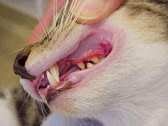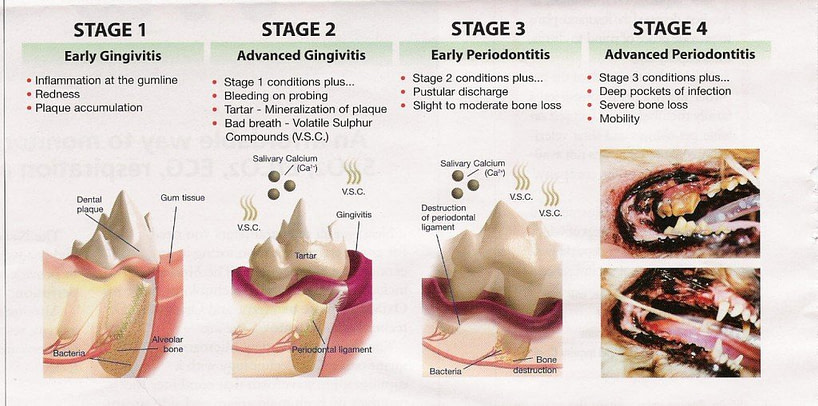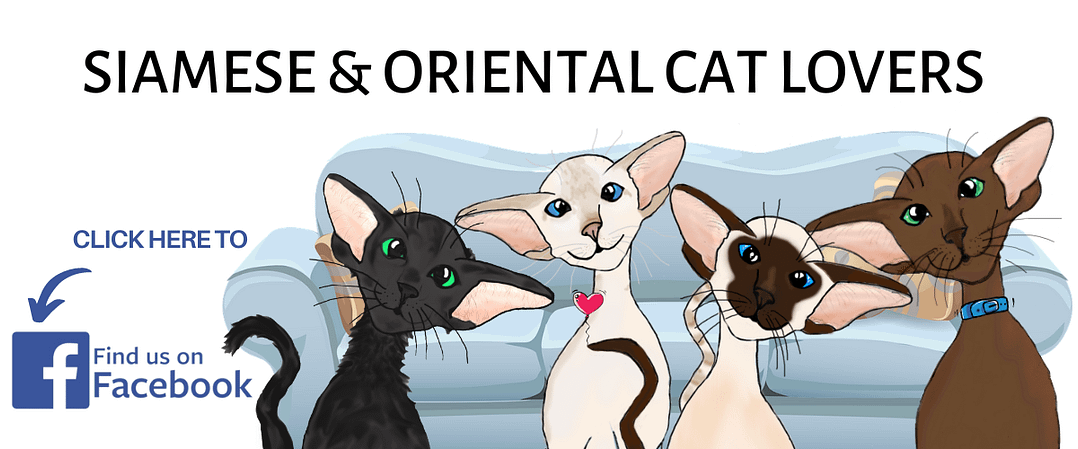Cats With Bad Breath and a Smile Without Sparkle!
Cats with bad breath and a smile without sparkle is the third in a series of articles specially researched and written for Siamese Cat Breeder relating to dental care and oral hygiene for cats by Sheila Calloway RVN
Sheila is a qualified veterinary nurse and has over 30 years experience working with and keeping pets. Many of you will have seen Sheila at cat shows and she is usually found on the Siamese section with her cats.
What a Pong – Bad Breath and a Smile Without Sparkle!
If your cat has bad breath (halitosis) then it is usually down to two reasons:
The first and least likely is the type of diet you are feeding your cat, as some cat foods, especially softer wet foods, or unprocessed or raw flesh such as fish, can leave a strong odour for several hours after eating. This is usually only temporary, easily recognisable and the obvious and easiest solution is to refrain from feeding smelly foods!
However if the odour is really bad, is present all the time and quite literally causes you to feel slightly nauseous or gasp desperately for fresh air before removing the offending source from your lap, then it is likely to be something much more sinister and needing veterinary intervention – and the sooner the better!
Poor diet, genetics, stress, and age all play a role in the development of feline dental problems. Some cats are genetically predisposed and may develop dental problems at a younger age and lack of a good oral hygiene regime for your cat will most certainly lead to some serious problems.
Gingivitis
Gingivitis is reddening of the gum area around the base of the tooth. Some cats are have sensitive gums and are more susceptible to this condition – in particular Siamese cats. My Chocolate neuter boy, Coco is one of them!
However it is also very common in most cats and it is imperative that a regular oral regime is maintained to prevent and treat the condition before it escalates into something far more problematic.
But, some gingivitis isn’t down to oral sensitivity or just poor oral hygiene
Stomatitis is the name given to the process that results in gingivitis. It is an autoimmune disorder in which the cat’s gums become inflamed and extremely painful. The cat’s body produces an exaggerated immune response to bacteria and plaque.
The cause of this immune response is unknown, though cats with FIV (feline immunodeficiency virus) and FeLV (feline leukemia virus) are particularly susceptible.

Periodontal Disease is also Known as Gum Disease
Periodontal disease is a serious disease of the teeth and gums and is the most common clinical condition occurring in adult cats, and is entirely preventable![divider_flat]
From Gingivitis to Peroidontis:

Unfortunately, other than bad breath (halitosis), there are few signs of the disease process evident to owners and professional dental cleaning and periodontal therapy often comes too late to prevent extensive disease or to save teeth. As a result, periodontal disease is usually under-treated, and may cause multiple problems in the oral cavity and may be associated with damage to internal organs in some patients as they age.

Plaque is a sticky ‘biofilm’ composed mostly of bacteria (predominantly streptococcus) which forms on the teeth.
Bacteria present in the plaque residing in the inner gum (sub-gingival) area will set in motion a cycle of damage to the supporting tissues around the tooth, eventually leading to loss of the tooth.
Tartar is yellowish in colour & is seen along the tooth where it meets the gum (gingiva). This leads to inflammation of the gums, which is known as gingivitis.
Note: At this stage, proper treatment can reverse the problem.
Very early stages of plaque and tartar building up on a healthy tooth – note reddening of gums is already present.
Left untreated the tartar begins to collect under the gum line. Tartar will continue to build up under the gum line, separating the gum from the tooth.[divider_flat]
Note: Once this happens, the cat has irreversible periodontal disease!
Bacteria under the gum line will secrete toxins, which contribute to damage tissue if untreated. These bacteria also stimulate the animal’s immune system. The initial changes cause white blood cells and inflammatory chemical signals to move between the gum or bone and the tooth (periodontal space).
The function of the white blood cells is to destroy the bacterial invaders, but chemicals released by the overwhelmed white blood cells cause damage to the supporting tissues of the tooth. Instead of helping the problem, the cat’s own protective immune system actually worsens the disease when there is severe build-up of plaque and tartar.
Periodontal disease includes inflammation or reddening (gingivitis) of the gums and loss of bone and soft tissue around the teeth (periodontitis).
Note: Unhealthy teeth & gums have greater impact on the body than just causing bad breath, pain & infection. The gums have a rich blood supply and so the bacteria are readily transported to other organs (such as the liver, kidneys etc.) in the body causing damage & even organ failure.[divider_flat]
Effects of Periodontal Disease in Cats
Effects within the oral cavity include damage to or loss of gum tissue and bone around the teeth, development of a hole (‘fistula’) from the oral cavity into the nasal passages causing nasal discharge, fractures of the jaw following weakening of the jaw bone, and bone infection (‘osteomyelititis’). Bacteria from the mouth can also enter the bloodstream and are carried around the body.
What are the Symptoms of Periodontal Disease in Cats?
Our felines are experts at masking discomfort & pain and many of us may not notice that our cat has a problem.
This is another important reason why regular, annual check-ups with the veterinarian are so important.
Even if you believe your cat is in good health, a thorough physical may uncover a problem in the early stages, thus avoiding unnecessary pain, suffering, expense & prolonged treatment to fix the problem.
Unfortunately, unless you check your cat’s mouth regularly, by the time you notice a problem, the disease is likely to be advanced.
Symptoms common to periodontal disease may include
- Bad breath, this is probably the most obvious sign a pet owner will notice
- Unwillingness to eat
- Yellow deposits on the teeth
- Avoiding dry/hard food in favour of softer food
- Drooling
- Pawing at the face
- Pus around the tooth/teeth
- Gums which bleed easily
- Red or swollen gums, especially along the gum line
- Pus around the teeth
- Teeth which are loose or missing
- Stomach or intestinal upsets
- Lethargy, isolating
Picture of cat with periodontal disease – notice the yellow/brown tartar and plaque eating into both gums and teeth and the sore swelling and reddening (inflammation) of the gums.
Table showing the different stages, signs and symptoms of peridontal disease in cats:
|
Grade |
Plaque and Calculus |
Gum Health |
Radiologic Changes |
Prognosis |
|
|
Early Gingivitis |
Grade I |
Mild amount of plaque |
Mild redness |
No change |
Reversible |
|
Advanced Gingivitis |
Grade II |
Subgingival plaque |
Redness and edema (swelling at gumline) |
Little change |
Reversible |
|
Early Periodontitis |
Grade III |
Larger amounts of subgingival calculus |
Redness, edema, gums bleed with gentle probing, gum recession or hyperplasia |
Subgingival calculus, 10-30% loss of bone support |
Irreversible |
|
Established Periodontitis |
Grade IV |
Larger amounts of subgingival calculus |
Severe inflammation, gum recession, loose teeth and/or missing teeth, pus around gumline, gums bleed easily, deep pockets |
How do Vets Treat Periodontal Disease?
Treatment depends upon the grade assigned to the severity of the problem. In all cases, a pre-surgical examination will be conducted by your vet
Grade I or Grade II:
- A routine professional dental cleaning and polishing (prophylaxis) under anesthetic will be performed on cats with Grade I or II disease.
- The plaque and tartar build-up will be removed from the teeth, both above and below the gum line.
- The teeth are then polished to remove microscopic scratches that predispose to plaque formation and calculus build-up.
- Each tooth and the entire oral cavity are checked for any disease.
- Fluoride may also be applied.
Grade III and Grade IV:
- After the teeth are scaled, probing and dental radiology will be performed in order to select the appropriate treatment. Treatment options include:
- Root planing: involves removing residual calculus and diseased bony tissue covering the root of a tooth (cementum) and smoothing the root surface.
- Removal of diseased connective tissue below the gum line
- Irritants to the tooth and root surface such as bacteria are removed (periodontal debridement)
- Excess gum tissue is removed as the area between this excess tissue and the tooth is a perfect habitat for bacteria (gingivectomy)
- Periodontal surgery: These surgeries involve opening a flap of the gum over the root of the tooth to be able to reach the deeper structures.
- Tooth extraction: In some cases, a tooth cannot be saved or the owner elects not to have other procedures performed. In these cases, tooth extraction is the only alternative.
What Aftercare is Required for my Cat Post-Peridontal Treatment?
Cats with Grade I or II disease will be placed on a regular brushing and dental care program to control plaque through the use of chemical (cat toothpaste)and mechanical removal (brushing with a cat toothbrush). The cat may also have a special prescription dental diet recommended.
Cats with Grade III or IV disease will need to be placed on several types of therapy. Owner commitment to this care is crucial.
Pain and anti-inflammatory medication: Medication for pain relief and to decrease the amount of inflammation may be administered post-operatively and for several weeks following the dental procedures.
Antibiotics: Antibiotic therapy is important.
Topical medications: Products containing plaque preventives such as: zinc ascorbate, stannous fluoride or chlorhexidine, may need to be applied to the teeth on a regular basis. Don’t panic these are often sourced in toothpastes and /or oral hygiene water supplements or can be prescribed by your vet!
Diet: Depending on the situation, it may be necessary to feed your cat only soft food for the week or so after treatment whilst the mouth is still very tender. Your veterinarian may then suggest feeding your cat a specialized dry diet that helps control the build-up of plaque and tartar.
Brushing: Your veterinarian will explain to you the best tooth brushing routine for your cat. You may need to wait until your cat’s mouth heals before starting to brush. Often you will start out with a soft finger brush for the first 2-3 months and then graduate to a bristle brush.
Regular check-ups: Felines with periodontal disease will need frequent check-ups to assess their oral health. For some cats, it may be advisable to recheck gum pocket depth 4-6 weeks after treatment. For others, routine examinations 2-4 times a year will be needed.
Prevention of Gingivitis & Peridontal Disease in Cats
Gingivitis can occur even in cats with an excellent oral hygiene regime, so it is imperative feline’s with on-going problems are taken to the vets for treatment and/or further investigation.
Some vets may treat recurrences with intermittent antibiotics and/or occasional steroid injections to support your oral hygiene regime; once all other causes such as FIV (feline immunodeficiency virus) and FeLV (feline leukemia virus) have been eliminated
Tips for Prevention Rather Than Cure!
- Vaccinations and maintenance of regular annual boosters.
- Regular examinations of your cats mouth and gums by both you and your vet.
- Feeding your cat dry, hard “kibble” type food frequently, will help scrub off plaque and help prevent tartar from forming.
- Feeding your cats semi-wet/dry foods if your cats has over-sensitive gums
- Regular brushing with a toothbrush and mild pastes – pet pastes are available from most pet retail outlets.
- Use of oral hygiene supplements in water e.g., Dentagen.
NB once or twice weekly is usually sufficient, too much may result in diarrhea – you have been warned!
Coming soon on Siamese Cat Breeder! Tooth Decay in Cats.
Please add your comments or any questions below and I will be happy to answer you.





